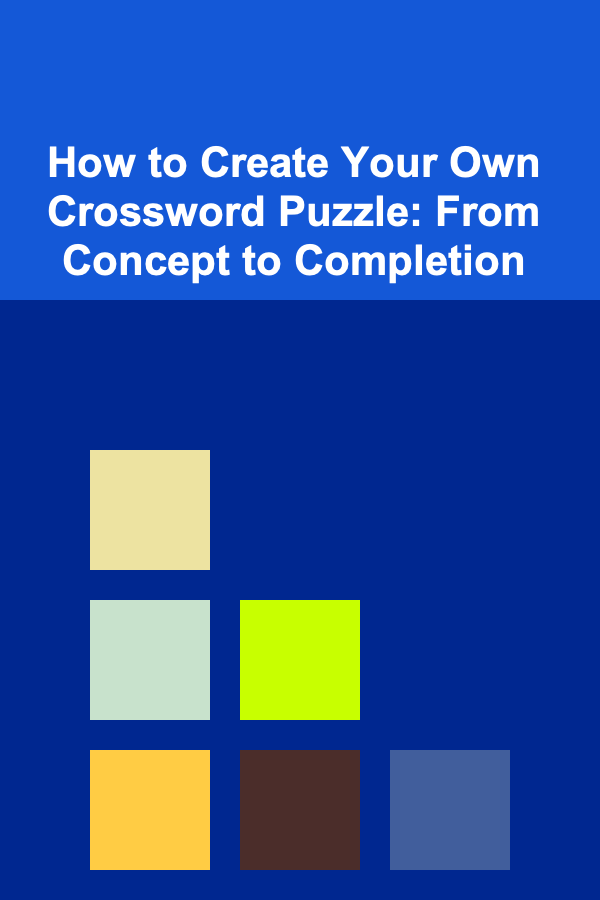
How to Create Your Own Crossword Puzzle: From Concept to Completion
ebook include PDF & Audio bundle (Micro Guide)
$12.99$6.99
Limited Time Offer! Order within the next:

Crossword puzzles are a timeless form of entertainment and mental exercise, offering both fun and a challenge for enthusiasts of all ages. Whether you're an experienced puzzle creator or just starting, making your own crossword puzzle is a rewarding process that involves both creativity and logic. This article will guide you through the entire journey, from conceptualizing your puzzle to completing the final design.
Creating a crossword puzzle may seem complex at first, but by breaking down the process into manageable steps, you can craft a puzzle that's both engaging and satisfying. Here, we will explore the essential steps, tools, and tips for creating your own crossword puzzle, ensuring that your final product is both challenging and fun for solvers.
Conceptualizing Your Puzzle
Every great crossword puzzle starts with a clear idea or theme. The first step is to conceptualize what kind of crossword puzzle you want to create. This will determine everything from the words you choose to the structure of your grid. Your concept could be anything from a specific topic, like geography, literature, or history, to a more abstract theme, such as pop culture or wordplay.
Types of Crossword Puzzles:
- Themed Crossword Puzzles: These puzzles revolve around a particular theme, where most of the answers are connected in some way. For instance, a puzzle about cities might have answers like "Paris," "Tokyo," and "London."
- Cryptic Crosswords: These puzzles use wordplay, often including clues that involve anagrams, homophones, or hidden meanings. They tend to be more difficult but are highly popular with enthusiasts.
- Standard Crosswords: These are the most common type of crossword puzzles, often found in newspapers. They feature a simple grid with horizontal and vertical clues.
Step 1: Decide on the Type of Puzzle
Determine whether you want to create a themed crossword or a standard one. Themed puzzles require a greater level of creative planning as you need to ensure that all your answers fit the theme. In contrast, standard puzzles offer more flexibility with word choices.
Step 2: Choose a Theme (for Themed Crosswords)
If you opt for a themed crossword, choose a subject that you are passionate about or one that will resonate with your audience. This could be anything from a favorite hobby to a specific subject like famous movie quotes, sports, or animals. Keep in mind that the theme should be broad enough to allow for a variety of answers but specific enough to provide a sense of coherence.
Designing the Grid
Once you've decided on the theme and overall structure of your puzzle, the next step is designing the grid. This step involves determining the size of your puzzle, arranging the black squares (which separate the words), and making sure that all the words fit properly.
Grid Size and Layout:
Most standard crossword puzzles have a 15x15 grid, though you can create smaller or larger grids depending on your preference. If you're new to puzzle-making, start with a 13x13 or 15x15 grid, as these sizes are more manageable.
- Standard Puzzle Grid: A grid consisting of white and black squares, where the white squares are where the words go, and black squares are used to separate them. The black squares can either be arranged in a symmetrical pattern or a more freeform layout.
- Symmetry: Traditional crossword grids often feature symmetrical black squares. This means that the grid looks the same if you rotate it 180 degrees. While symmetry isn't a strict rule, it's a convention that adds to the aesthetic appeal and balance of the puzzle.
- Blocked vs. Open Grids: Some puzzles have a fully blocked grid, where no white squares touch the grid's edges. Open grids, on the other hand, have white squares that touch the edges of the grid. The choice of grid type will depend on your design preferences.
Step 1: Plan Your Word List
Start by brainstorming a list of words that fit your theme. For a themed puzzle, ensure that these words are related in some way to the theme. If you're creating a standard puzzle, choose words that vary in length and difficulty. Aim for a mix of short (3--4 letter) and long (7--8 letter) words to add diversity.
Step 2: Sketch the Grid
You can use graph paper, an online crossword grid generator, or crossword puzzle software to sketch your grid. Start by placing your longest words in the grid, as these will provide the foundation for the puzzle. Then, add shorter words around them. Ensure that every word crosses at least one other word and fits within the grid.
- Ensure Word Intersections: Each word in the grid should intersect with another word, either vertically or horizontally. This is crucial for creating a cohesive and solvable puzzle.
- Check for Flexibility: After placing a few words, step back and assess whether there are enough open spaces for additional words. You may need to adjust placements if the grid becomes too tight.
Step 3: Fill in the Black Squares
Once your words are placed, fill in the black squares. Try to make the pattern as symmetrical as possible, and avoid leaving too many isolated white squares.
Creating the Clues
The next step in the puzzle creation process is writing the clues. Writing clues is both an art and a science, as you need to strike a balance between difficulty and fairness. You want to ensure that the clues are challenging enough to engage solvers but not so obscure that the puzzle becomes frustrating.
Step 1: Write Clues for Each Word
- For Themed Puzzles: Ensure that the clues reflect the theme. For instance, in a puzzle about cities, a clue might be "Capital of France" (Answer: Paris).
- For Standard Puzzles: The clues should be straightforward, often using definitions or synonyms. For example, a clue might be "A large body of water" (Answer: Ocean).
Step 2: Vary the Difficulty
Your puzzle should include a mix of easy, medium, and difficult clues to appeal to solvers of all skill levels. Easy clues might be direct definitions or common knowledge facts, while harder clues can involve wordplay, anagrams, or less common definitions.
- Straightforward Clues: These are clear and direct definitions of the answers. For example, "Fruit often used in pies" (Answer: Apple).
- Cryptic Clues: These can involve wordplay, such as using anagrams, homophones, or double meanings. For example, "Not quite a full cup (4)" might be a cryptic clue for "Half."
Step 3: Number the Clues
Number the clues according to the order in which they appear in the grid, starting with 1 across and 1 down. This numbering system should be consistent and easy for the solver to follow.
Testing and Refining the Puzzle
Once you have created the grid and written the clues, it's time to test the puzzle. Testing ensures that your puzzle is solvable and that the clues are clear and fair.
Step 1: Solve the Puzzle Yourself
First, try solving your own puzzle. This will help you identify any mistakes in the grid or clues. Pay attention to whether the clues make sense and whether there are any ambiguous or difficult spots.
Step 2: Have Others Test It
After solving it yourself, ask friends, family, or colleagues to solve the puzzle. Their fresh perspective can help uncover any issues or confusing clues you might have missed. Take note of their feedback, especially if they struggle with specific clues or word placements.
Step 3: Refine the Puzzle
Based on the feedback you receive, make any necessary adjustments to the grid, clues, or difficulty level. It's common to go through several rounds of refinement before settling on a final version of the puzzle.
Finalizing Your Puzzle
Once you've tested and refined your puzzle, it's time to finalize it. This involves creating a clean, polished version of your puzzle, formatting it for presentation, and deciding how you want to share it with others.
Step 1: Create a Neat Version
Ensure that your final puzzle is easy to read and solve. If you're printing it out, make sure the font is clear and the grid is easy to follow. If you're sharing it online, consider using an online crossword puzzle generator to produce a neat, interactive version.
Step 2: Add a Solution
Don't forget to create an answer key. This will allow solvers to check their answers after completing the puzzle. Include both the filled-in grid and the list of answers for each clue.
Step 3: Share Your Puzzle
Decide how you want to share your puzzle with others. You could publish it in a newsletter, post it on a website, or print it out for friends and family to enjoy.
Conclusion
Creating your own crossword puzzle is a fulfilling and creative process that allows you to engage your mind and share your love for puzzles with others. Whether you choose to create a simple standard crossword or a complex themed puzzle, the key is to plan, design, test, and refine your puzzle to ensure it's both fun and solvable. With the right approach, you can craft a challenging and enjoyable crossword puzzle that will provide hours of entertainment for solvers.
Reading More From Our Other Websites
- [Home Cleaning 101] How to Clean and Care for Stainless Steel Appliances
- [Organization Tip 101] The Different Types of Textured Paint and Their Uses
- [Whitewater Rafting Tip 101] Choosing the Perfect Rafting Helmet: A Comprehensive Buying Guide
- [Personal Investment 101] The Top Ways to Make Money with Deep Learning Models and Algorithms
- [Tie-Dyeing Tip 101] Sustainable Style: Eco‑Friendly Materials for Stunning Stripe Tie‑Dye Projects
- [Home Staging 101] How to Stage a Kitchen Island: Accessorize and Declutter Like a Pro
- [Organization Tip 101] How to Make Donations in Memory of Loved Ones
- [Screen Printing Tip 101] Step-by-Step: How to Create Custom Stencils for Perfect Prints
- [Home Family Activity 101] How to Set Up a Backyard Obstacle Course for Family Fun
- [Home Pet Care 101] How to Build an Outdoor Catio on a Budget: Creative and Affordable Solutions for Providing Safe Outdoor Access

How to Use Project Management Tools for Paperwork Control
Read More
Proven Strategies for Lowering Business Insurance Premiums Without Sacrificing Coverage
Read More
Mastering Time Management for Leaders
Read More
Grasping the Principles of Quantum Teleportation: A Deep Dive
Read More
How to Edit Photos for Print vs. Digital
Read More
10 Tips for Networking and Finding Opportunities as a Video Game Designer
Read MoreOther Products

How to Use Project Management Tools for Paperwork Control
Read More
Proven Strategies for Lowering Business Insurance Premiums Without Sacrificing Coverage
Read More
Mastering Time Management for Leaders
Read More
Grasping the Principles of Quantum Teleportation: A Deep Dive
Read More
How to Edit Photos for Print vs. Digital
Read More